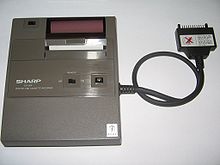Thermal printing(ordirect thermal printing) is adigital printingprocess which produces a printed image by passing paper with athermochromiccoating, commonly known asthermal paper,over a print head consisting of tiny electrically heated elements. The coating turns black in the areas where it is heated, producing an image.[2]


Most thermal printers are monochrome (black and white) although some two-color designs exist.
Thermal-transfer printingis a different method, using plain paper with a heat-sensitive ribbon instead of heat-sensitive paper, but using similar print heads.
Design
editA thermal printer typically contains at least these components:
- Thermal head: Produces heat to create an image on the paper
- Platen:A rubber roller which moves the paper
- Spring:Applies pressure to hold the paper and printhead together
Thermal paper is impregnated with asolid-statemixture of a dye and a suitable matrix, for example, afluoranleuco dyeand anoctadecylphosphonic acid.When the matrix is heated above its melting point, the dye reacts with the acid, shifts to its colored form, and the changed form is then conserved in metastable state when the matrix solidifies back quickly enough, a process known asthermochromism.
This process is usually monochrome, but some two-color designs exist, which can print both black and an additionalcolor(often red) by applyingheatat two different temperatures.[3]
In order to print, the thermal paper is inserted between the thermal head and the platen and pressed against the head. The printer sends anelectric currentto theheating elementsof the thermal head. The heat generated activates the paper's thermochromic layer, causing it to turn a certain color (for example, black).
Thermal print heads can have a resolution of up to 1,200dots per inch(dpi). The heating elements are usually arranged as a line of small closely spaced dots.[4]
Early formulations of the thermo-sensitive coating used in thermal paper were sensitive to incidental heat,abrasion,friction(which can cause heat, thus darkening the paper), light (which can fade printed images), andwater.Later thermal coating formulations are far more stable; in practice, thermally printed text should remain legible for at least 50 days.[citation needed]
Applications
editThis article needs to beupdated.The reason given is: Printing and display technology progresses. There's been less need for hard copies, and better non-thermal printers as well, shifting the demand and application of thermal printers. The comparison with the largely obsolete (for about 20 years!) technology of dot-matrix impact printing is very emblematic for this issue.(August 2024) |
Thermal printers print more quietly and usually faster than impactdot matrix printers.They are also smaller, lighter and consume less power, making them ideal for portable and retail applications.
Commercial use
editCommercial applications of thermal printers includefilling stationpumps, informationkiosks,point of salesystems, voucher printers inslot machines,print on demandlabels for shipping and products, and for recording live rhythm strips on hospital cardiac monitors.
Record-keeping in microcomputers
editMany popular microcomputer systems from the late 1970s and early 1980s had first-party and aftermarket thermal printers available for them, such as theAtari 822printer for theAtari 8-bit computers,theApple Silentypefor theApple II,and theAlphacom 32for theZX SpectrumandZX81.They often use unusually-sized supplies (10CM wide rolls for the Alphacom 32 for instance) and were often used for making permanent records of information in the computer (graphics, program listings etc.), rather than for correspondence.
Fax machines
editThrough the 1990s, manyfax machinesused thermal printing technology. Toward the beginning of the 21st century, however,thermal wax transfer,laser,andinkjetprinting technology largely supplanted thermal printing technology in fax machines, allowing printing on plain paper.
Seafloor Exploration
editThermal printers are commonly used in seafloor exploration andengineering geologydue to their portability, speed, and ability to create continuous reels or sheets. Typically, thermal printers found in offshore applications are used to print realtime records ofside scan sonarandsub-seafloor seismicimagery. In data processing, thermal printers are sometimes used to quickly create hard copies of continuous seismic or hydrographic records stored in digitalSEG YorXTFform.
Other uses
editFlight progress strips used inair traffic control(ACARS) typically use thermal printing technology.
In many hospitals in theUnited Kingdom,many commonultrasoundsonogramdevices output the results of the scan onto thermal paper. This can cause problems if the parents wish to preserve the image by laminating it, as the heat of mostlaminatorswill darken the entire page—this can be tested beforehand on an unimportant thermal print. An option is to make and laminate a permanent ink duplicate of the image.
TheGame Boy Printer,released in 1998, was a small thermal printer used to print out certain elements from someGame Boygames.
Health concerns
editReports began surfacing of studies in the 2000s finding the oestrogen-related chemicalbisphenol A( "BPA" ) mixed in with thermal (and some other) papers. Whilethe health concerns are very uncertain[citation needed],various health and science oriented political pressure organizations, such as theEnvironmental Working Group,have pressed for these versions to be pulled from market.[5]
See also
editReferences
edit- ^"Receipt Paper: Why It Fades and How to Restore It?".Panda Paper Roll.2018-12-10.
- ^"Definition of THERMAL PRINTER".merriam-webster.
- ^Diamond, Arthur S. (2018-10-08).Handbook of Imaging Materials.CRC Press. p. 445.ISBN978-1-4822-7736-4.
- ^"Thermal Print Head | Toshiba Hokuto Electronics Corporation".hokuto.co.jp.
- ^"Concerned About BPA: Check Your Receipts".Science News.Retrieved2021-04-19.